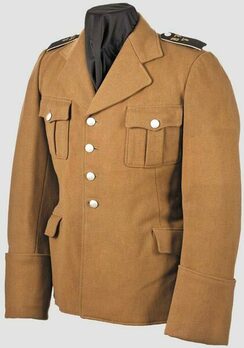HJ Service Tunic (2nd pattern 1936 version)
CATEGORY: Version
SKU: 31.GOR.02.01.01.01.002.002
Estimated market value:

Estimated market value:
In general, the uniforms of the male Hitler Youth members consisted of a top, a neckerchief and woggle – but a tie for officers –, bottoms, a belt, knee socks, and shoes or boots.
The service tunic was introduced in a regulation from January 19, 1935. It was worn by Leaders of a Gebiet (district), department heads of the Reichsjugendführung (RJF, National Youth Leadership), the Adjutant to the Reichsjugendführer, and the Staff Leader of the RJF.
There are five separate versions of this item, a 1935 version and four 1936 versions.
This garment might have been a slightly altered version of the general Waffenrock, which was introduced in 1933.
The 1935 service tunic consists of light brown wool gabardine. It has a lay-down collar with open lapels, and features four pockets, two pleated breast pockets with a buttoned scalloped flap, and straight-edged bellowed patch hip pockets, again with a buttoned scalloped flap. The hip pockets are the main identifier of this version. There was also a concealed breast pocket on the left side in the interior lining.
It is closed in the front by four buttons. The cuffs are rolled-back cuffs. At the side and the back it comes with metal belt ramps. Depending on the rank of the wearer, these are either in matte grey, matte silver, or matte gold colour.
The buttons are made of natural-coloured brown leather, but not the buttons holding the shoulder straps. They are either in matte grey, matte silver, or matte gold colour. As with the belt ramps, this was decided by the rank of the wearer.
The second version, the 1st pattern of 1936, only had one difference to the 1935 version: the hip pockets are unpleated.
A few more changes were instituted for the 2nd pattern version of the same year. The hip pockets of this version are concealed pockets with a straight-edged buttoned flap. The buttons were no longer made from leather, but, according to the rank of the wearer, are made of either matte grey, matte silver-coloured, and matte gold-coloured metal. A regulation from July 4, 1936 also stated that the colour was changed to to a darker shade of brown. This way it was similar to the colour worn by the Political Leaders.
The 3rd pattern version of 1936 had the hip pockets changed yet again. They are slanted slash (concealed) pockets with a buttoned scalloped flap.
The service tunic of the Leaders of the Naval Hitler Youth is identical to the 1936 3rd pattern version, but made of dark blue wool gabardine with gold buttons. Gold anchor buttons, however, were strictly prohibited.
The 4th pattern version of 1936 was introduced on November 6. It is a bit darker in colour. The hip pockets were changed yet again to slit pockets with a buttoned flap.
The service tunic of the Aviation HJ members was identical, except that after 1938 all items worn during the winter months (October 15 to April 14) or during flying exercises were of Luftwaffe blue-grey colour.
Members of Aeronautical Preparatory Technical Schools (Fliegertechnische Vorschulen) in the rank of Hitlerjunge to Oberscharführer also wore the Luftwaffe blue-grey colour. It is unknown when this was first introduced.
Students and Leader ranks of National Political Educational Institutes (NPEAs) wore the regular HJ tunic, but for pre-military training (Geländedienst) they wore a four pocket olive brown service tunic with a black collar.

Comments
Sign in to comment and reply.


Scroll Top